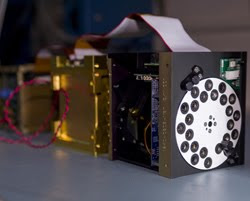
More than one hundred days ago, on Nov. 19, 2010, NASA sent a small satellite about the size of a loaf of bread on an important mission to answer astrobiology’s fundamental questions about the origin, evolution and distribution of life in the universe. Since then, the nanosatellite, known as Organism/Organic Exposure to Orbital Stresses (O/OREOS) continues on its quest, which has taken it just about everywhere between the Arctic and Antarctic Circles more than 400 miles above Earth's surface. O/OREOS weighs approximately 12 pounds and is NASA’s first CubeSat to demonstrate the capability to have two distinct, completely independent science experiments on a single autonomous satellite.
O/OREOS is using NASA’s first propellant-less mechanism on a scientific satellite to ensure it de-orbits and burns up as it re-enters Earth’s atmosphere, less than 25 years after completing its mission. It's also the first nanosatellite to not only operate, but also conduct autonomous biological and chemical measurements, in the region of space known as the exosphere. "The fact that we're getting consistently good science data in such a challenging environment tells us that secondary payload nanosatellites like O/OREOS can be made rugged enough to enhance our opportunities to conduct research in low Earth orbit," said Antonio Ricco, instrument scientist for O/OREOS and a researcher at NASA's Ames Research Center, Moffett Field, Calif. "This is enabling us to study organics, microorganisms, and astrobiology in the space environment in real time."
O/OREOS was a secondary payload aboard a U.S. Air Force four-stage Minotaur IV rocket launched from the Alaska Aerospace Corporation’s Kodiak Launch Complex on Kodiak Island, Alaska. After O/OREOS separated from the rocket and successfully entered low Earth orbit, it activated and began transmitting radio signals to ground control stations and spacecraft operators in the mission control center at Santa Clara University, Santa Clara, Calif. Nearly daily two-way communications with the spacecraft provided valuable information about its health, status and science data, and have given scientists the ability to fine tune the science payloads’ operating parameters.
O/OREOS is using NASA’s first propellant-less mechanism on a scientific satellite to ensure it de-orbits and burns up as it re-enters Earth’s atmosphere, less than 25 years after completing its mission. It's also the first nanosatellite to not only operate, but also conduct autonomous biological and chemical measurements, in the region of space known as the exosphere. "The fact that we're getting consistently good science data in such a challenging environment tells us that secondary payload nanosatellites like O/OREOS can be made rugged enough to enhance our opportunities to conduct research in low Earth orbit," said Antonio Ricco, instrument scientist for O/OREOS and a researcher at NASA's Ames Research Center, Moffett Field, Calif. "This is enabling us to study organics, microorganisms, and astrobiology in the space environment in real time."
O/OREOS was a secondary payload aboard a U.S. Air Force four-stage Minotaur IV rocket launched from the Alaska Aerospace Corporation’s Kodiak Launch Complex on Kodiak Island, Alaska. After O/OREOS separated from the rocket and successfully entered low Earth orbit, it activated and began transmitting radio signals to ground control stations and spacecraft operators in the mission control center at Santa Clara University, Santa Clara, Calif. Nearly daily two-way communications with the spacecraft provided valuable information about its health, status and science data, and have given scientists the ability to fine tune the science payloads’ operating parameters.
No comments:
Post a Comment